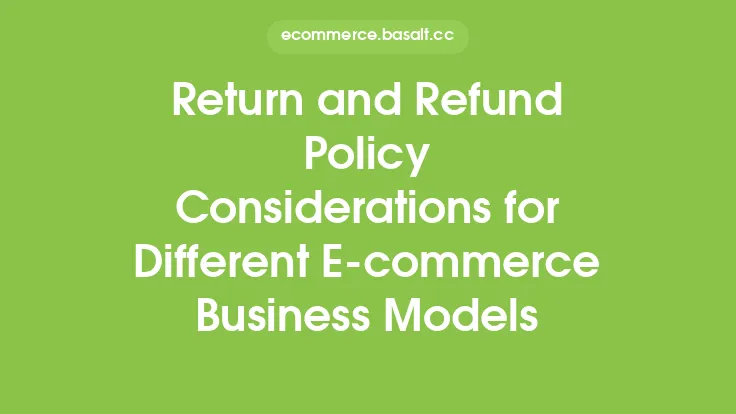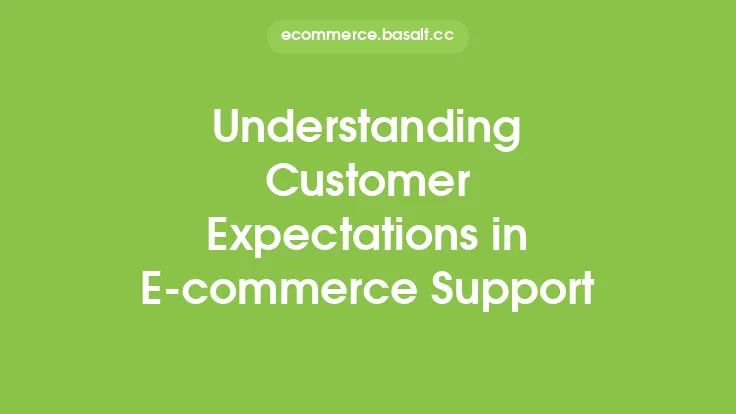In the world of e-commerce, return and refund policies are essential components of any online business. These policies outline the procedures and guidelines for customers to return or exchange products, and receive refunds or store credits. Understanding return and refund policies is crucial for both e-commerce businesses and customers, as they can significantly impact the overall shopping experience, customer satisfaction, and loyalty.
What are Return and Refund Policies?
Return and refund policies are documents that outline the rules and procedures for returning or exchanging products, and receiving refunds or store credits. These policies typically include information on the types of products that can be returned, the time frame for returns, the condition of the products, and the process for initiating a return or refund. Return and refund policies can vary significantly from one e-commerce business to another, depending on the type of products sold, the target audience, and the business model.
Key Components of Return and Refund Policies
There are several key components that are typically included in return and refund policies. These include:
- Return window: The time frame during which customers can return products, usually ranging from 15 to 30 days.
- Return conditions: The condition in which products must be returned, such as in their original packaging, with all tags and accessories included.
- Refund options: The options available for refunds, such as store credits, exchanges, or monetary refunds.
- Restocking fees: Fees charged to customers for returning products, usually ranging from 10% to 20% of the product's price.
- Shipping costs: The responsibility for paying shipping costs for returns, which can be borne by either the customer or the e-commerce business.
Types of Return and Refund Policies
There are several types of return and refund policies, including:
- No-questions-asked return policy: A policy that allows customers to return products without providing a reason.
- Conditional return policy: A policy that requires customers to provide a reason for returning products, and may only allow returns for certain reasons, such as defects or incorrect orders.
- Store credit return policy: A policy that provides store credits instead of monetary refunds.
- Exchange-only return policy: A policy that only allows customers to exchange products, rather than receiving refunds.
Benefits of Clear Return and Refund Policies
Clear return and refund policies can have several benefits for e-commerce businesses, including:
- Increased customer trust and confidence: By providing clear and transparent return and refund policies, e-commerce businesses can demonstrate their commitment to customer satisfaction and build trust with their customers.
- Reduced returns and refunds: By outlining the conditions and procedures for returns and refunds, e-commerce businesses can reduce the number of returns and refunds, and minimize the associated costs.
- Improved customer satisfaction: Clear return and refund policies can help to ensure that customers are satisfied with their purchases, and can reduce the likelihood of disputes and complaints.
Best Practices for Implementing Return and Refund Policies
There are several best practices that e-commerce businesses can follow when implementing return and refund policies, including:
- Clearly outlining the return and refund procedures on the website and in marketing materials.
- Providing multiple refund options, such as store credits, exchanges, and monetary refunds.
- Offering a reasonable return window, such as 15 to 30 days.
- Minimizing restocking fees and shipping costs for returns.
- Responding promptly to customer inquiries and concerns about returns and refunds.
Common Challenges and Considerations
E-commerce businesses may face several challenges and considerations when implementing return and refund policies, including:
- Balancing customer satisfaction with business needs: E-commerce businesses must balance the need to provide flexible return and refund policies with the need to minimize costs and maximize profits.
- Managing returns and refunds across multiple channels: E-commerce businesses that sell products through multiple channels, such as online marketplaces and physical stores, must manage returns and refunds across these channels.
- Complying with laws and regulations: E-commerce businesses must comply with laws and regulations related to returns and refunds, such as consumer protection laws and tax laws.
Technology and Tools for Managing Return and Refund Policies
There are several technologies and tools that e-commerce businesses can use to manage return and refund policies, including:
- Return management software: Software that automates the return process, including tracking returns, processing refunds, and communicating with customers.
- E-commerce platforms: E-commerce platforms, such as Shopify and Magento, often include built-in tools and features for managing returns and refunds.
- Customer service software: Software that enables customer service teams to manage customer inquiries and concerns about returns and refunds.
Conclusion
Return and refund policies are essential components of any e-commerce business, and can significantly impact the overall shopping experience, customer satisfaction, and loyalty. By understanding the key components, types, and benefits of return and refund policies, e-commerce businesses can create effective policies that balance customer needs with business requirements. By following best practices, using technology and tools, and considering common challenges and considerations, e-commerce businesses can manage returns and refunds efficiently and effectively, and build trust and loyalty with their customers.





